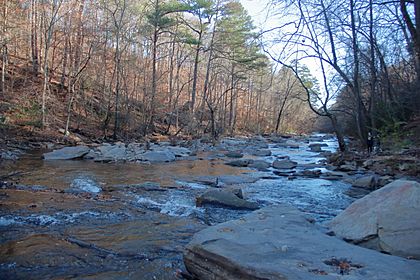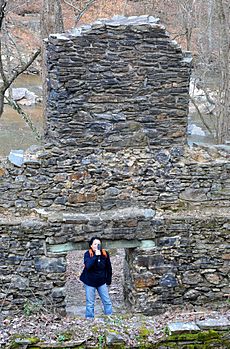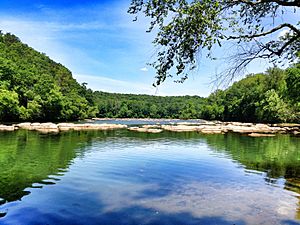Sope Creek facts for kids
Sope Creek is a stream in Cobb County, Georgia, United States. It is about 11.6 miles (18.7 km) long. Sope Creek is an important smaller river that flows into the Chattahoochee River. In the 1800s, it was sometimes called Soap Creek. Part of Sope Creek flows through the Chattahoochee River National Recreation Area, which is a special park.
The Sope Creek Ruins are old buildings near the creek that are listed on the National Register of Historic Places. This means they are important historical sites.
Contents
Where Sope Creek Flows
Sope Creek begins in the city of Marietta. It starts as a spring, a place where water naturally comes out of the ground. The creek then flows south and east, winding its way through the land.
Along its journey, two other smaller creeks, Sewell Mill Creek and Bishop Creek, join Sope Creek, adding more water to it. The creek crosses several roads, like Roswell Road and Lower Roswell Road.
As it gets closer to the Chattahoochee River, Sope Creek drops about 300 feet (91 meters) in height over its 12-mile (19 km) path. In its last two miles, the creek cuts through tall cliffs, forming a small gorge or valley.
Many places in the area are named after Sope Creek, like Sope Creek Elementary School, Sope Creek Nature Trails, and local neighborhoods. This shows how well-known the creek is in the community.
The Old Covered Bridge Story
Near where Sope Creek flows into the Chattahoochee River, there used to be a special bridge called a covered bridge on Paper Mill Road. In the 1960s, this was one of only two covered bridges left in Cobb County.
A covered bridge is a wooden bridge with a roof and sides, like a tunnel. It helps protect the wooden parts of the bridge from weather, making it last longer.
This old bridge was very old and could only hold light vehicles, about 2,000 pounds (907 kg). In 1963, a truck that was too heavy crossed the bridge and damaged it. The bridge was fixed with steel supports.
Sadly, on March 29, 1964, the covered bridge burned down. People thought someone might have set it on fire on purpose, especially because another nearby covered bridge had also been partly burned a few weeks before. A new, wider bridge was built in 1970, and it was replaced again in 2013 with an even better one that has sidewalks.
How Sope Creek Got Its Name
No one knows for sure how Sope Creek got its name, but there are a couple of interesting stories. Sometimes, a story about a name's origin isn't quite true; this is called a "false etymology."
The "Soap" Story
One idea is that the creek was named "Soap Creek" because of how the water looks. The Atlanta Journal newspaper once wrote that the creek has many rocks, and the water rushes over them, making lots of foam. This foam can look like "soapsuds" or soap bubbles. Some old records from the 1800s also spelled it "Soap Creek."
The "Old Sope" Story
Another story, supported by the National Park Service, says the creek was named after a Cherokee Native American man called "Old Sope." He supposedly lived in the area, perhaps even after the Trail of Tears, when many Cherokee people were forced to leave their homes.
More recent information suggests that the Cherokee man's name was "Soap," and he lived in the area before the Trail of Tears. He was well-respected by the white settlers. The creek was even called Soap Creek on maps from 1832. However, he and his family were later forced to move. His descendants live in Oklahoma today. The spelling of the creek's name changed from "Soap" to "Sope" sometime in the 1800s.
Sope Creek Ruins
At the meeting point of Paper Mill Road and Sope Creek, you can find old industrial ruins. These are the remains of a large factory complex that used the power of the creek's flowing water.
From the 1850s to the 1940s, different businesses operated here. These included a paper mill (which made paper), a twine plant (which made string), a flour mill (which ground grain into flour), and even a hydroelectric power plant (which used water to make electricity).
The paper mill, called Marietta Paper Mills, started in 1859. It had many buildings, including the mill itself, an office, a dam, and a machine shop. These ruins were added to the National Register of Historic Places in 1973, recognizing their importance to history.
Ferry at Sope Creek
In 1851, a man named James Isom started a ferry service that crossed the Chattahoochee River right where Sope Creek flows into it. A ferry is a boat that carries people and goods across a river. James Isom became quite wealthy from this business. After he died in 1866, his son-in-law, John Heard, took over and ran the ferry, known as Heard's Ferry, until 1890.
Sope Creek and the Civil War
Sope Creek played a part in the American Civil War, especially during General William T. Sherman's Atlanta Campaign. This was when Union troops first crossed the Chattahoochee River near Sope Creek.
In 1864, General William T. Sherman led the Union Army against Confederate General Joseph E. Johnston and his Army of Tennessee. Sherman had many more soldiers than Johnston. Johnston wanted to fight a defensive battle, meaning he would wait in strong positions for Sherman to attack. Sherman, however, kept trying to go around Johnston's army, forcing Johnston to retreat. This went on for almost two months.
The biggest river between where Sherman started (Chattanooga, Tennessee) and Atlanta was the Chattahoochee River. Crossing this river was a risky moment for Sherman's army, as it could be split up and attacked.
As the Union Army got close to the Chattahoochee, Sherman planned to have his troops cross the river in different places to surprise Johnston. He ordered General Schofield to find a good spot between Roswell and Sope Creek to cross. Schofield found a shallow place to cross about half a mile upstream from where Sope Creek meets the Chattahoochee.
Schofield's soldiers crossed the river at this shallow spot. They then built a pontoon bridge (a temporary bridge made of floating sections) at Isom's Ferry, which was just below the mouth of Sope Creek. This allowed more troops and supplies to cross.
For about 36 hours, Schofield's troops were on the other side of the river, somewhat separated from the rest of Sherman's army. This was a chance for Johnston to counter-attack, but he was completely surprised. Most of his forces were still on the west side of the river.
Schofield reported to Sherman that his troops had crossed without losing a single man. The enemy was surprised and fled, leaving behind a cannon.
By the evening of July 8, Schofield had moved four divisions of troops to the east bank of the Chattahoochee. Fearing that Sherman would go around his army, Johnston had no choice but to leave the west side of the river. He retreated into Atlanta, burning the railroad bridge behind him.
Because of this surprise crossing and retreat, Confederate President Jefferson Davis decided to replace General Johnston with General John Bell Hood.




